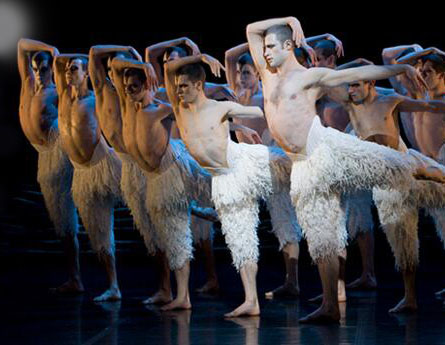
‘The idea of a male swan makes complete sense to me. The strength, the beauty, the enormous wingspan of these creatures suggests to me the musculature of a male dancer more readily than a ballerina in her white tutu.’ So said Matthew Bourne, and there is no doubt that his version of Swan Lake is best known for having a male dancer play the lead role of ‘The Swan’, supported by an all-male corps-de-ballet. But there is far more to Bourne’s Swan Lake than mere gender-juggling. In many ways, a more interesting aspect of Bourne’s achievement is that he has taken the central idea of the story back to its dark, mythic origins.
There are many ancient legends that tell of mysterious, shape-shifting beings that inhabit lakes and seas, ready to lure mortal men to a watery end. These tales explore sexual anxieties, transgressive desires and social taboos. But in the 19th century there was a tendency to soften these stories, often by portraying the water-dwelling creatures as innocent victims of their own beauty, or by framing the story in a Christian context. Hans Christian Andersen’s The Little Mermaid and Pushkin’s Rusalka are prime examples. Tchaikovsky’s Swan Lake followed this prettifying pattern. In that 1895 ballet, the swan is a princess who is pure in heart, beautiful, and utterly powerless; she is the epitome of Victorian notions of femininity. But then, in 1995, Sadler’s Wells Ballet premiered Bourne’s revolutionary re-imagining of the tale. Originally intended for a two-week London run, over the past twenty-three years this show has become a world-wide phenomenon. One obvious reason for its popularity is that it firmly knocks on the head any preconceptions that ballet has to be an effete, overly precious art form. Bourne’s swans are downright dangerous, the kind that could break a man’s arm with one blow of their wings. Prettiness is cast aside in favour of aggression, menace and angular muscularity.
At its most serious, Bourne’s Swan Lake is a bleak, Freudian psychodrama, but the darkness is frequently leavened by parody, sharp wit, and a sense of fun. There is also a depth of characterisation that gives each of the main roles a convincing solidity. The dancing is seldom there merely to display the performers’ skilled footwork; each vigorously choreographed sequence pushes the narrative onwards. Great attention has been paid to stage-business, so that there is always some telling detail to catch the eye. Indeed, there are times when perhaps there is a little too much going on, so that one doesn’t quite know on which part of the stage to focus attention. This is especially true of the ‘Moth Ballet’ scene, where we see a very funny pastiche of a traditional romantic ballet, running simultaneously with comic goings-on in the royal box.
Last night’s Prince was Dominic North, who has been a principal performer with Bourne’s New Adventures company for ten years. He invests the role of the Prince with a touching, boyish vulnerability. Bored by stiff protocol and tedious ribbon-cutting ceremonies, he has mastered that royal wave, but you know that his thoughts are elsewhere. Bemused and bewildered by conflicting emotions, he is a tortured soul desperate for his mother’s affection and understanding. But the Queen, regally remote and icily elegant, keeps her son at arm’s length. Nicole Kabera conveys her haughty froideur with every precisely controlled gesture, yet there is more than a hint that her frosty exterior belies an inner sensuality. One character whose sensuality is most certainly not hidden is that of the Prince’s wildly unsuitable girlfriend, played hilariously by Katrina Lyndon. More at home in a nightclub than a palace, she is a sparkly, leggy blonde with a happy knack of trampling all over the polite niceties of a royal court. Yet she has real heart, and her undeserved, violent end has real poignancy.
In the dual role of The Swan and The Stranger, Will Bozier is utterly mesmerising. Whether clad in white feathers or black leather trousers, he is a threatening, alien predator. In the thrilling Royal Ball scene, he swiftly establishes himself as alpha male, sweeping all the women off their feet before latching on to the Queen herself. She responds with passionate abandon, and the Prince’s appalled reaction to his mother’s behaviour has more than a touch of Hamlet about it.
Lez Brotherston’s sets are magnificent, and Paule Constable’s lighting design very effectively enhances every shift in mood. The dancing is excellent throughout, from the stamping and hissing of the swans to the refined grace and elegance of the courtiers. Tchaikovsky’s music, of course, is wonderful. What would he have made of this show? We cannot know, but given his own inner demons, he would surely have recognised the psychological veracity of this powerful piece of work. Five stars seems almost miserly. ★★★★★ Mike Whitton 13th March 2019

